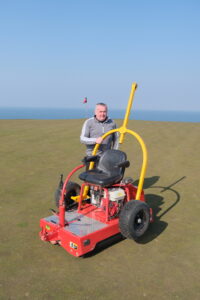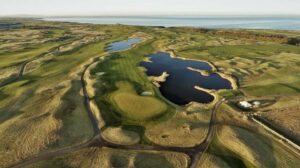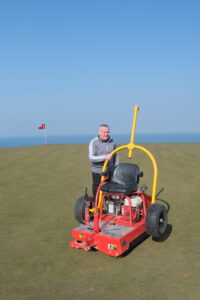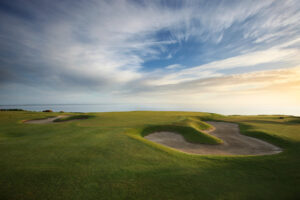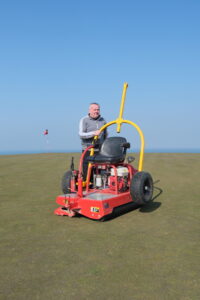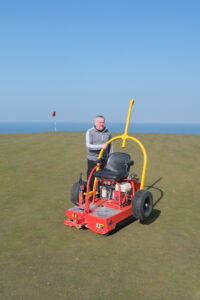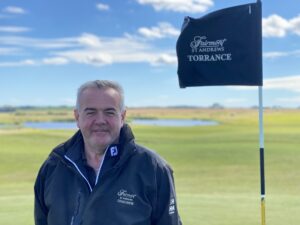Meet the head greenkeeper: Craig Bayne
Related Articles
Bayne, from Fairmont St Andrews, talks about creating naturally healthy greens, the importance of supporting staff to take work-based qualifications and his plans to replicate Fairmont’s 2020 success as a host club for the European Tour this year.
Fairmont St Andrews is a 520 acre coastal resort set on the cliffs above St Andrews Bay.
It comprises two traditional links courses, the Torrance and the Kittocks, which were highly praised during the 2020 European Tour, with one newspaper declaring that ‘rarely … has a course being showcased for the first time by Sky Sports Golf earned such glowing praise’. Fairmont will be one of the hosts of Final Qualifying for the Open on June 28, 2022 and will host a European Tour event at the end of July.
Here, we speak with head greenkeeper Craig Bayne about his work at this prestigious venue.
Can you give a brief description of your background and how you came to work at Fairmont St Andrews?
I lived locally in Kingsbarns when I was approached by a construction company about doing finishing works for Fairmont St Andrews – destoning, levelling and seeding fairways.
I then moved on to their grow-in team and then switched to the hotel’s greenkeeping grow-in team. I then stayed on as a greenkeeper and did all the fertiliser and sprayer work, and started doing a lot of irrigation work.
Can you tell us about the two courses and what makes them stand out?
They are resort courses, championship length. They’re both over 7,000 yards from the blue tees but they can go down to approximately 5,400 yards off the reds, so it does cater for most people. We’ve got standard revetted bunkers. We’ve always had a reputation for good greens, which makes us stand out. The courses themselves are built on quite heavy, clayish ground, so they can get a little bit wet in the winter, but in summer they’re great. We’ve had a lot of good comments from the European Tour over the last two years, and the players as well. It’s especially good to get feedback from the players. You get guys like [former world number one] Lee Westwood putting posts up about our greens [in 2020 Westwood asserted, “You’re not going to see better greens all year, they’re absolutely immaculate. I think they’re some of the best links greens I’ve ever seen.” Richie Ramsay and Aaron Rai also praised the Torrance course, stating that it “is almost unheard of for greens to be like this in the middle of October” and commenting on the “great condition with stunning views around the whole place” respectively]. It was quite a statement.
You’re now head greenkeeper. How did you get that position and what are your main ambitions for the role at the moment?
I spent a period away from Fairmont and went down to work at my home club, Crail Golf Club, as deputy head greenkeeper. I was down there for six years but I’ve been back at Fairmont now for ten years and I came back as head greenkeeper. There was a course manager above me to begin with but not for the last two years. My main ambition at the moment is to successfully get through the European Tour and the qualifying rounds. I think the team we’ve got at the moment can meet the challenge.
We’ve been working on our greens quite intensively since I took over, scarifying and increasing the topdressing up to 150 tonnes a year. There’s too much thatch at different depths of the sand profile so we’re working on reducing that. We also changed our fertiliser to a more organic-based fertiliser, with minimal conventional liquid and seaweed, so we’ve really cut back on the nitrogen levels. We’re generally trying to get the greens to work for themselves more, without us needing to fight them all the time. We’ve seen a huge difference in the surface firmness and we’re not getting the disease outbreaks we were either.
What do you enjoy most about your job and what is the biggest challenge you and your team face when maintaining the course?
I enjoy my job in general but especially being out and about with the team and on my own. I especially enjoy looking after the irrigation side of things. I don’t like getting stuck in the office for too long, which is happening a bit more often at the moment. It’s a great job when you can be out in the fresh air, although it can get a bit too fresh at times!
I would say our biggest challenge at the moment is just where we’ve come from and what we’re trying to achieve. When the resort opened up the courses were traditional American-style, so the remit was that they wanted to keep the courses bright green in colour at all times. We have moved away from that and have massively reduced fertiliser inputs. It can be difficult to keep the fairways hydrated at times during the season with the current thatch levels as the clay based soil dry out very quickly but we’re working hard on this now with more aeration works and an additional wetting agent programme.
Another big challenge at the moment, as it is for many greenkeepers, is that we are struggling a bit with some of our machinery; our fleet, like all fleets, is getting older and is predominantly from 2010. It can get a little bit frustrating when we’re getting regular breakdowns but we’re working to keep up with that.
What’s your proudest achievement in the job so far?
I think what the whole team achieved in 2020 was quite remarkable. From having just two guys looking after the golf course during the first lockdown, to having five weeks to prepare for a major event and getting the feedback we got from players.
Lee Westwood’s comments on the greens were brilliant and Pádraig Harrington also commented on the excellent condition of the whole course. It was very satisfying to hear that after the short space of time we’d had to achieve it. It was a really big achievement by the whole team and we hope to maintain our reputation this year.
How big is your team and do they all have specific responsibilities?
We’re trying to build the squad back up at the moment after the pandemic. We’re back up to 11, plus myself, a mechanic and two gardeners. I’ve got two senior greenkeepers at the moment. We lost a deputy greenkeeper last year but we’re hoping to recruit another two full-time greenkeepers plus a deputy to get back up to a full squad soon.
During the initial lockdown I was working here with one other greenkeeper. Unfortunately the pandemic hit before we’d finished our winter work and we were in the middle of turfing our chipping green, so we finished all that and spring fertilising, and then the two of us were just cutting grass for the summer. I got another three staff back at the start of June 2020 and then just after that it was announced that we’d been given a European Tour event, so I got everybody back and we had five weeks to prepare because it was only confirmed to be going ahead at short notice. That was a bit of a challenge.
You’ve got a Final Qualifying event for the Open and a European Tour event this year, can you tell us a bit about them and how you’re preparing for them?
We’re trying to do the majority of greens work prior to the events at the moment. We’ve started topdressing and the DryJect is booked in, and then another topdressing on top. We’re trying to get as much aeration work done as we can at the moment so we can keep it to a minimum going forward. We’re actually starting to get quite busy now. The season seems to have kicked off quite early this year.
You’ve just ordered your second Tru-Turf RC-50 roller. Why did you select that particular piece of equipment?
I feel it’s the best machine of its kind on the market right now. It’s got everything we need. I first used a smaller Tru-Turf iron down at Crail and I think they’re fantastic machines. We’re getting very good results out of it. Of course, the European Tour and the Open qualifying events are two-tee starts, so we need two teams going on each nine and it’s imperative that we have the two identical machines working together for maintaining green speeds and so on. We were so pleased with the first one we had to get another one to match. It’s very efficient at getting speed easily and we get a lot of comments about how smooth it performs.
Do you have an issue with green speeds?
We don’t have a great problem here getting good green speeds, but when we do the Tru-Turf RC-50 is a great machine to use for getting the speeds up very quickly. We can’t go too fast here anyway, and the European Tour gets a bit nervous if we go past 10.5. A flat, calm day here usually means 10 to 15 mile per hour winds so we have to be careful, but the RC-50 helps us stay on top of things.
How user-friendly is the roller?
It’s very easy to learn to use and everyone on the team enjoys using it. When I asked them their opinions on which turf iron we should purchase, the vast majority voted for the Tru-Turf. It’s a popular machine here!
What advice would you give to anyone hoping to follow the same career path as you?
I’d say just to stick in, work hard and the rewards generally come along. I’m seeing a lot of greenkeepers in the industry as a whole potentially leaving in their early 20s when they get commitments because the pay can be quite low to begin with, but I would say stick at it. It’s a great shame to lose people from the profession. I think it’s also important to get as many qualifications on the job as quickly as you can. I encourage my team to study and we’ve got two people taking level 2 qualifications at the moment that will hopefully go on to level 3 if they wish to. One of the older team members has just joined us from a different job and he wants to go on to college in the autumn to take his level 3 qualification, so we’re going to support him through that. Any relevant qualifications you can get will make a difference. I do try to help my team to progress as much as they can, even if it means they eventually move on to another club, because it benefits the industry as a whole to have good people in it.

